Properties of Sensory Channels
A Taxonomy, and Connections with User Interface Design
Summary
Regardless of what display technologies or other output
devices are used, a human ultimately perceives
information from a computer through the familiar
senses of sight, hearing, touch, etc.
This paper explores some of the basic properties
of the different sensory channels,
classifies them within a taxonomy,
and tries to find useful analogies in
user interfaces.
Finally, speculations on how aliens might sense their
environment and interact with each other are given.
The observations made offer a new way of thinking
about certain types of interaction.
Note that these observations are not
limited to just interaction between a human and computer,
but touch on more general kinds of interaction between
abstract entities.
Introduction and Motivation
At an anatomical level, there are many details that make each
sensory channel different. However, at a more abstract level,
some basic differences and similarities are apparent.
For example,
- The information available to us visually depends on the
direction we look in. Indeed, to find out if something
is even visible from our current position,
we must first look and scan in
all directions to see if it is anywhere in sight.
Hearing, on the other hand, can be done more passively,
since it does not matter which way our head or ears happen
to be oriented -- the sound around us remains perceptible.
(As a consequence, a source of light can sneak up behind us
without us noticing it, however a source of noise cannot.)
- Some sensory information, such as light and sound, can
travel a great distance from its source to our senses.
Other information, such as the faint smell of a flower
or the texture of a rough surface, must be actively
sought out:
We must physically displace ourselves in order to sense
the information.
- We can always tell where the source of a light is:
visual information implicitly carries with it information
about the direction it came from.
In contrast, a strong smell that fills the room
may have no obvious source.
It is also interesting to think about some of the physical
quirks of our senses. For example, if both light and sound are
waves, why is it that our eyes can form images from light waves,
but our ears cannot form images from sounds waves ?
Or, why is it that our eyes only sense 3 primary colours,
but our ears can sense thousands of different frequencies
of sound ?
Even more, why is it that we have 2 eyes, 2 ears, and 2 nostrils ?
What are the advantages of having pairs of sensory
organs, and are the reasons the same in all cases ?
Thinking about these and similar issues, I was motivated
to try and enumerate the basic, abstract properties of senses
and sensory information, and to create a taxonomy.
In so doing, I hope to
(i) find analogies between the
properties of sensory channels and
aspects of user interfaces that may help
inform the understanding and design of user interfaces and virtual worlds,
and (ii)
speculate on what possible sensory channels
may be relevant to alien beings on another planet,
and what the consequences might be on their way
of interacting with their environment, and perhaps even
what their computer output devices may be like.
Concepts and Terminology

|
|
Figure 1.
Imagine an observer, equipped with sensors,
who goes out exploring a world full of sources of
information.
What are the different ways that the observer may acquire information ?
What different types of sensors might the observer be equipped with ?
|

|
|
Figure 2.
Different possibilities for sensors.
A: an omnidirectional sensor that does not discriminate between
different directions.
B: a parabolic mirror enables the creation of a unidirectional
sensor that can be rotated to detect information
coming from a specific direction.
C: an array of sensors, each of which is "tuned" to a different
information component. (Examples of this arrangement of sensors
is in the human ear, where cilia in the cochlea are tuned
to detect different
frequency components of sound, and in the human nose, where
odours are detected by receptors tuned to various
different molecules.)
D: an array of sensors combined with a lens, enabling the formation
of an image. (Cones on the human retina work like this,
and in addition there are three different types of cones, tuned to
red, green, and blue frequencies of light respectively.)
It would also be possible to form an image using an array
of unidirectional sensors, such as the one in B, each
pointing in a slightly different direction.
|
Taxonomy of Sensory Channels
The below table is a taxonomy showing different properties
of information and sensors, and shows where the human senses
(and some other instruments) exist within the taxonomy.
Objections could be raised at some of the classifications,
and many details and possible extra dimensions have been omitted.
However, this taxonomy is proposed as a useful compromise
between excessive detail and uninformative simplicity.
The colour coding of the table gives an indication of the effort
involved in each sensory activity.
|
information is spatially localized (it can't travel far from its source) |
information travels or propagates across space 1 |
| information diffuses or meanders across space |
information travels in straight line (rectilinear propagation) 2 |
| sensors are omnidirectional (orientation of sensor doesn't matter) |
sensors are unidirectional (they detect information coming from a given direction) 3 |
| small number of sensor(s) |
large array of sensors that form an image |
| sensors cannot distinguish different components (e.g. frequencies) within the information |
cutaneous sensing of texture;
cutaneous sensing of temperature |
|
light meter;
noise meter;
ocelli (simple eyes) |
|
|
| different components (e.g. frequencies) can be filtered or independently detected in the information |
a small number of different components are sensed by different sensors |
|
|
|
|
human eye |
| sensors can be tuned to detect different components |
|
|
tunable radio receiver |
radio telescope |
|
| large array of sensors that each detect a different, fixed component (so an entire range of components is perceived simultaneously) |
human taste;
faint odours (e.g. scent of a flower);
faint sounds (e.g. whisper) |
human smell |
human ear |
"parabolic"-shaped ear;
echolocation in bats (?) |
|
| Colour Legend: |
|
Active sensing: To obtain information, the observer must use locomotion to displace herself (or an appendage, such as a finger or antenna). She must go to the information. |
|
Semi-active sensing: Although information flows to the observer, the observer may have to scan in different directions or across different components to find the information. |
|
Passive sensing: The information is ambient or pervasive, constantly flowing to the observer, who can perceive it (as if it were always in the background) without effort. |
| Footnotes (regarding the determination of direction
and distance to a source of information): |
| 1 |
In this case, an observer
equipped with a pair of sensors could detect the approximate
gradient, i.e. the
direction from which the information is coming.
This is one reason, for example, humans have two ears,
and may be the reason many animals have two nostrils
(although dogs are often seen waving their snout to and fro
when sniffing the air, suggesting how gradient
detection can done with a single sensor). |
| 2 |
In this case, if the information travels with a constant speed,
then an observer
equipped with three sensors could conceivably
estimate the
direction and distance
to a source of information.
Seismologists use this technique to determine the epicentre
of an earthquake.
It is also possible emit a pulse of information, and use
a single sensor to measure the time for the pulse to return,
to determine the distance to an
object. This principle is used in radar, sonar,
and many auto-focus cameras.
|
| 3 |
In this case, the direction
to a source is of course
implied by the orientation of the sensor.
Furthermore, an observer equipped with two sensors could use
triangulation
to estimate the distance to the source of
information.
Humans use their two eyes this way. |
Analogies in User Interfaces
The active-passive scale
Sullen et al. [sellen1992] identity five different dimensions for
characterizing feedback.
One of these is "demanding" versus "avoidable" feedback,
denoting whether the user can choose to monitor or ignore the feedback.
This is very similar to the active-passive scale
(see definitions of Active, Semi-Active, and Passive Sensing
in the colour legend)
used in the above taxonomy of sensory channels.
In this paper, however, rather than limiting our attention to feedback,
we wish to describe any information that may be "out there",
e.g. on a computer, and of potential interest to a user.
The active-passive (or demanding-avoidable) scale serves as a
measure of the effort required to retrieve a given
piece of information.
From a design perspective, we would like important
or frequently accessed information
to be retrievable with as little effort as possible.
We now consider different schemes for achieving this
within a user interface.
A good example of passively-sensed (or demanding, or ambient) information
is audio output. Sullen et al. [sellen1992] reference work by
Monk [monk1986] where "Monk argued that sound is a good choice for
system feedback in that users do not constantly look at the display
while working." [sellen1992, p. 142]
Indeed, as already indicated by our taxonomy,
auditory information from a computer
can be perceived without effort on the part of the user
(assuming the user has not become so habituated to the audio
output that she is simply ignoring it).
Baecker et al. agree, using the words "ubiquitous" and
"localized" [baecker1995, p. 526]
to describe audio and visual channels, respectively.
Another potential channel for delivering ambient information
is smell. Although there are practical problems,
devices that output different odours do exist
[kaye2001].
Some sensory channels which our taxonomy classifies as active
(i.e. requiring effort) can be made more passive
in a user interface setting
by virtue of the limitations of the output devices involved.
For example, if a computer is equipped with a small, low-resolution
screen, and the user has no reason to look away from the screen,
we may assume that the user can passively sense all information
on the screen without ever changing their general direction of gaze.
Similarly, if the user's hand never leaves a mouse, the user
can passively sense the kinesthetic feedback of pressing a mouse
button down without having to first move their finger to the button.
One scheme, then, for output of visual information that can be
sensed passively (or almost passively) is to make the information
occupy a large area of the screen, so it is visible wherever
the user looks.
This scheme does not preclude the display of other information.
An anecdotal example helps explain this.
Users of window managers with multiple virtual desktops
can often keep track of the currently active desktop using a small,
zoomed-out "map" of all desktops. This map is typically
located in the corner of the screen.
I once encountered a user who, to avoid having to glance at such
a map, had configured his system to change the background image
whenever he changed desktops. The background images were chosen
to make it easy to see which desktop he was currently in
(Figure 3), wherever his attention happened to be focused on the screen.

|
|
Figure 3.
A screenshot showing a background "wallpaper" image that
reminds the user they are in virtual desktop #2.
Wherever the user happens to look, the numeral 2 is
easily perceived in the background image, which
creates a kind of ambient (or passively sensed) information.
|
Sellen et al. [sellen1992] used a similar strategy to try and make
visual feedback as salient as possible.
In their studies of mode errors, the visual feedback used to
indicate a mode change was a change in the background colour
of the entire screen.
Another possibility for making visual information easily perceived
is to place it at a common focal point of the user, e.g. the
mouse cursor, so it is obtrusive and unlikely to go unnoticed.
Many user interfaces exist which change the mouse cursor depending
on the system's current mode.
McGuffin et al. [mcguffin2002b] describe the design of an interaction
technique in which a slider widget temporarily becomes
attached to the mouse cursor. They suggest that this creates
"visual tension" [mcguffin2002b, p. 41],
analogous to kinesthetic tension [buxton1986, sellen1992],
which reminds the user of what is occurring.
As we move along the scale from passive sensing to active sensing,
we encounter the notion of displaying information in a corner of the
screen or in a status bar. Although such information is always
visible, the user must make a (small) effort to look at it, and may
easily forget or otherwise fail to do so.
In keeping with the taxonomy of sensory channels, we may say
that such information is sensed semi-actively.
This partly motivates the idea of using gaze as a channel
for input
[ware????,zhai????,vertegaal2002]:
it arguably requires less effort to "point"
with one's eyes than with one's hand or finger.
Indeed, Argyle and Cook point out that
gaze "must be treated both as a channel and a signal" [argyle1976, p. xi].
Finally, although a user sitting at a desktop computer need
not displace their body very much, they nonetheless do
navigate and travel through virtual worlds,
which motivates the notion of active sensing
on a computer. Any time a user must, for example,
click on a button to bring up information, or scroll to a desired area,
or fly through a virtual world to find something,
they are actively retrieving information. This is analogous
to an observer who actively goes out into their environment to acquire
tactile information.
An interesting scheme for making such navigation easier was suggested
by Pierce et al. [pierce1999]. In 3D virtual worlds, the user often
needs to "look around" their point of view to orient themselves.
This is relatively easy and natural to do in the real world, however,
in many interfaces for navigating 3D, this can be cumbersome.
Pierce et al. introduced the notion of "glances" for better
supporting panning in a virtual 3D world: the user can quickly
look away from their current direction,
and when they are done glancing in the new direction,
their view snaps back to the previous direction.
In summary, we have seen how the active-passive scale for
classifying sensory channels has direct analogies within
user interfaces.
Speculations on Extra-terrestrial Life
It is interesting to imagine alien beings in alien environments
whose sensory organs are variations on human senses, or that
fill in some of the blanks in the taxonomy.
This exercise can lead to thought experiments akin to
Thomas Nagel's oft cited "What Is It Like to Be a Bat ?"
[nagel1974] [dennett1991, pp. 441--448]
(see Dawkins [dawkins1986, Chapter 2: Good Design]
for a description of the auditory
system of bats, and how they can "see" with sound, in some sense).
Many of us are taught from an early age about the 3 primary
colours of light. Mixing together these 3 colours allows any
visible colour to be synthesized.
What is perhaps not as emphasized, however,
is that these 3 primary colours are merely an artifact of human
biology: the colour associated with a given distribution of light
is determined by the excitation levels of the 3 types of cones
in our retina. These cones effectively sample a continuous
distribution at only 3 points: red, green, and blue.
Alien beings with 5 different kinds of cones, for examples,
would be able to see a richer range of colours, and could
perceive differences between colours that are indistinguishable
to a human.
Even more difficult to imagine is an alien capable of
directly sensing hundreds of different frequencies of light
(much like how the cilia in a human's inner ear are tuned
to hundreds of different frequencies of sound).
Would such beings experience light as a kind of music,
with rich melodic and tonal qualities ?
Would such beings "sing" luminous songs with special organs ?
Another bizarre possibility is that some aliens may have
sensory organs which can be tuned to detect different narrow
bands of frequencies, not unlike how a radio receiver is tuned.
If an alien species had, for example, tunable acoustic sensors
("ears"), and could also tune the pitch of their voice
to fall within one of many corresponding bands of voice,
it might be possible for a room full of such aliens to
carry on multiple, simultaneous conversations, without
separate conversational groups being audible to each other.
(This is akin to how many conversations can take place over
radio waves all at once, but without interfering with each
other because they take place on different frequency bands.)
One could even imagine two aliens who are carrying on a
private conversation within a secret frequency band, and
a third "spy" alien who sees their mouths moving, and decides
to try scanning different audio frequencies with her
ears until she finds the right band for eavesdropping.
This example shows how communication can involve multiple,
interacting sensory channels:
although the first two aliens tried to keep their conversation
private by using a secret audio band, they did not hide
the visual cue of their moving mouths from the
eyes of the third alien.
Gaze and mutual gaze in aliens
In humans, eyes serve both to take in visual information
from the environment, and also to send signals out to
others. In the very act of gazing somewhere, we cannot
help but reveal (to anyone looking at us) where we are looking
(unless we are wearing sunglasses).
We are all familiar with the social
interaction this can result in, e.g. when we "catch"
someone else staring at us, we may feel
threatened, challenged, flattered, etc. -- and we quickly
decide if we should look away or return the stare.
It is interesting that humans are one of
the few primates with a dark pupil surrounded by a white
sclera; this may be to enhance the visibility of our direction
of gaze [kobayashi2001a,kobayashi2001b].
The state of mutual gaze, or eye contact, between two people
is particularly interesting. Not only do the two individuals
become aware of each other's gaze, they are also aware that
each other is aware of this.
We might even be tempted to suppose that they are each
aware of the fact that each other is aware of this latter
statement, ad infinitum. Of course, such an infinite sequence
of deductions can't really be what
happens in our mind. Somehow, it seems sufficient that the
two parties involved be aware that their knowledge of the
situation is shared.
In any case, mutual gaze is a psychologically significant
situation: we know that one effect of being looked at
is heightened arousal [argyle1965][vertegaal2002].
It has also been of interest more generally:
the famous philosopher Jean-Paul Sartre [sartre1943] regarded
mutual gaze "as the key to `inter-subjectivity'" [argyle1976, p. x].
It is probably true that mutual gaze constitutes a kind
of "strange loop" or "tangled hierarchy", as defined by Hofstadter [hofstadter1979].
When one eye looks at another eye, the former becomes a meta-eye:
an eye that sees other eyes, like a sentence talking about
other sentences, or a vacuum cleaner that cleans other vacuum cleaners.
We can represent gaze abstractly using arrows.
Figure 4 shows one individual gazing at another,
and Figure 5 shows two individuals engaged in mutual gaze.
It is easiest to think about these figures in terms of
the human visual channel, however the notion of gaze can
be generalized to other sensory channels.
Imagine an alien species with a sensory organ that can be somehow adjusted
(either in orientation, or tuning, or otherwise)
to perceive different information,
and that this sensory organ reveals the state of its own adjustment,
emitting information about itself that can be perceived by other
individuals.
In the case of humans, the eyes are adjusted (in orientation)
to perceive information coming from different directions,
and the eyes themself emit a (visual) signal of where they are looking.
By analogy, one can imagine an alien whose ears can be tuned
to a given frequency band, and that may also (due to
evolution?) give off a sound
of a specific frequency to signal their current tuning.
Two such aliens can be engaged in mutual "acoustic" gaze,
by simultaneously perceiving each other's tuning.
Thus, in the notation used in Figures 4 and 5, if an arrowhead
touches the sensory organ of individual X, this means that the
originator Y of the arrow can perceive the tuning/orientation/adjustment
of X's sensory organ.
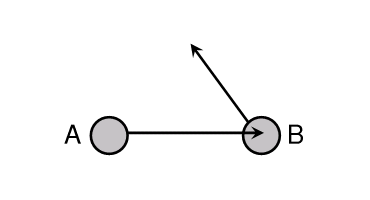
|
|
Figure 4.
A can see where B is looking, but B cannot see A.
Furthermore, A knows that B is oblivious to A's gaze.
If asked to draw a diagram representing this situation,
only A would be able to draw the above diagram.
|
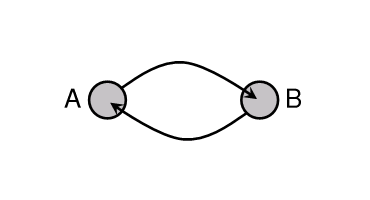
|
|
Figure 5.
Mutual gaze, or eye contact, as it occurs (for example) in humans.
A can see that B is looking at A, and B can see that A is looking at B.
Their knowledge of the situation is symmetric,
and furthermore A and B each know that their knowledge
is shared.
If asked to draw a diagram representing this situation,
A and B would each be able to draw the above diagram.
|
Things become more interesting if we allow for a second sensory
channel to play a role in gaze.
In Figures 6, 7, and 8, each individual is equipped with a second
sensory organ which senses information through a second channel
(dashed lines). We might imagine that the first and second channels
are visual and acoustic (e.g. perhaps the aliens emit a sound whose
frequency indicates the orientation of their eyes),
or perhaps both channels are visual, with one involving "visible"
light and the other infrared light.
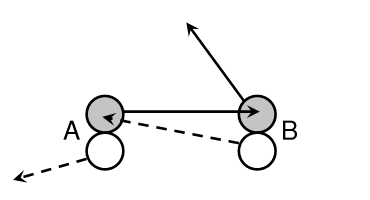
|
|
Figure 6.
A can see where B is looking.
However, unbeknownst to A, B can also sense where A is
looking, through a second sensory channel
(represented by dashes).
So B knows that A knows where B is looking,
but A does not know this.
|
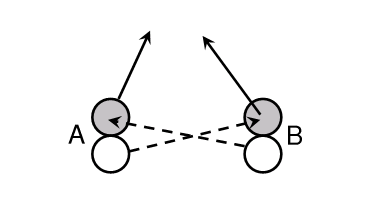
|
|
Figure 7.
Quasi-mutual gaze. Through a second sensory
channel (represented by dashes),
A and B can each sense where the other
is looking. However, neither A nor B are
aware that the other can sense where they are
looking. Hence, although the situation is symmetric,
and the knowledge that A and B each have of the
situation is symmetric, neither of them would be
able to draw the above diagram if asked to.
Each of A and B thinks that they are covertly spying
on the other.
It would seem, then, that none of the normal phenomena
associated with mutual gaze (e.g. signalling a threat,
dominance, interest, or love) could occur in this
situation.
(Note that the quasi-mutual gaze represented here is
somewhat akin to two humans looking at each other
through sunglasses, neither of them realizing that their
stares are being returned. Of course, this would only
involve one sensory channel, whereas in the diagram
we have two channels.)
|
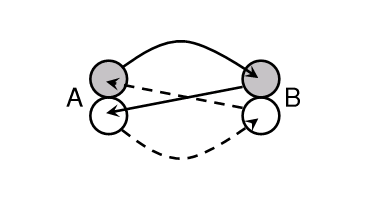
|
|
Figure 8.
Mutual "gaze" involving two sensory channels.
This is an elaborate situation where A and B each
use their two sensory organs to gain awareness of
the other's two sensory organs.
Each of A and B can deduce symmetric knowledge of
the situation, and also deduce that this knowledge is shared.
If asked to draw a diagram of the situation, each of
A and B would be able to draw the above diagram.
|
Finally, we may note that all the scenarios of mutual gaze
considered so far have involved only two individuals.
Of course, if the "gaze" is done using unidirectional
sensors, such as the human eye, then a "line of sight"
is necessarily involved, limiting mutual staring to dyadic groups.
However, were a different, omnidirectional channel involved,
it could be possible for N parties to be locked
in a mutual, shared, and simultaneous sensing of each other.
I leave it to the reader to wonder what kind of social
interaction such N-way mutual gaze could lead to.
Acknowledgements
Thanks to Brian Wong for providing some initial reactions
to this work.
References
@book{argyle1976,
author = {Michael Argyle and Mark Cook},
title = {Gaze and mutual gaze},
year = 1976,
publisher = {Cambridge University Press}
}
@article{argyle1965,
author = {Michael Argyle and J. Dean},
title = {Eye-contact, Distance and Affiliation},
journal = {Sociometry},
year = 1965,
volume = 28,
pages = {289--304}
}
@book{baecker1995,
author = {Ronald M. Baecker and Jonathan Grudin and William A. S. Buxton and
Saul Greenberg},
title = {Human-Computer Interaction: Toward the Year 2000},
year = 1995,
publisher = {Morgan Kaufmann},
edition = {2nd}
}
@inproceedings{buxton1986,
author = {William A. S. Buxton},
title = {Chunking and phrasing and the design of human-computer
dialogues},
booktitle = {Information Processing '86, Proceedings of the IFIP
10th World Computer Congress},
year = 1986,
pages = {475--480}
}
@book{dawkins1986,
author = {Richard Dawkins},
title = {The Blind Watchmaker},
year = 1986,
publisher = {Longman Scientific and Technical}
}
@book{dennett1991,
author = {Daniel C. Dennett},
title = {Consciousness Explained},
year = 1991,
publisher = {Little, Brown and Company}
}
@book{hofstadter1979,
author = {Douglas R. Hofstadter},
title = {G\"odel, Escher, Bach: An Eternal Golden Braid},
year = 1979,
publisher = {Vintage Books}
}
@mastersthesis{kaye2001,
author = {Joseph N. Kaye},
title = {Symbolic Olfactory Display},
school = {Massachusetts Institute of Technology},
year = 2001,
note = {http://web.media.mit.edu/\~jofish/thesis/}
}
% http://www.saga-jp.org/coe_abst/kobayashi.htm
@article{kobayashi2001a,
author = {Hiromi KOBAYASHI and KOHSHIMA},
title = {Unique morphology of the human eye and its adaptive
meaning: Comparative studies on external morphology
of the primate eye},
year = 2001,
journal = {Journal of Human Evolution},
volume = 40,
pages = {419--435}
}
% http://www.saga-jp.org/coe_abst/kobayashi.htm
@inbook{kobayashi2001b,
author = {Hiromi KOBAYASHI and KOHSHIMA},
title = {Primate Origin of Human Cognition and Behavior},
editor = {T. MATSUZAWA},
chapter = {Evolution of the human eye as a device for communication},
pages = {383--401},
publisher = {Springer-Verlag, Tokyo}
}
@inproceedings{mcguffin2002b,
author = "Michael McGuffin and Nicolas Burtnyk and Gordon Kurtenbach",
title = "{{FaST} Sliders: Integrating {Marking Menus}
and the Adjustment of Continuous Values}",
booktitle = "Proceedings of Graphics Interface 2002",
year = 2002,
month = "May",
location = "Calgary, Alberta",
pages = "35--41"
}
@article{monk1986,
author = {A. Monk},
title = {Mode errors: A user-centred analysis and some preventative
measures using keying-contingent sound},
year = 1986,
journal = {International Journal of Man-Machine Studies},
volume = 24,
pages = {313-327}
}
@article{nagel1974,
author = {Thomas Nagel},
title = {What Is It Like to Be a Bat?},
journal = {Philosophical Review},
year = 1974,
volume = 83,
pages = {435--450}
}
@inproceedings{pierce1999,
author = {Jeffrey S. Pierce and Matt Conway and Maarten Van Dantzich
and George Robertson},
title = {Toolspaces and Glances: Storing, Accessing,
and Retrieving Objects in 3D Desktop Applications},
booktitle = {Proceedings of ACM I3D'99
Symposium on Interactive 3D Graphics},
year = 1999,
pages = {163--168}
}
@book{sartre1943,
author = {Jean-Paul Sartre},
title = {L'Etre et le N\'eant},
year = 1943,
note = {Translated by H. Barnes, Being and Nothingness}
}
@article{sellen1992,
author = {Abigail J. Sellen and Gordon P. Kurtenbach
and William A. S. Buxton},
title = {The Prevention of Mode Errors Through Sensory Feedback},
year = 1992,
journal = {Human Computer Interaction},
volume = 7,
number = 2,
pages = {141--164}
}
@inproceedings{vertegaal2002,
author = {Roel Vertegaal and Yaping Ding},
title = {Explaining Effects of Eye Gaze on Mediated Group
Conversations: Amount or Synchronization?},
booktitle = {Proceedings of ACM CSCW 2002 Conference on
Computer Supported Collaborative Work},
year = 2002,
publisher = {ACM Press},
location = {New Orleans}
}
Copyright ( C ) Michael McGuffin, 2002
Written between July 31 and August 9, 2002
Based on ideas developed in 1999
Minor updates performed Jan 11, 2003
Minor update performed Mar 12, 2003







